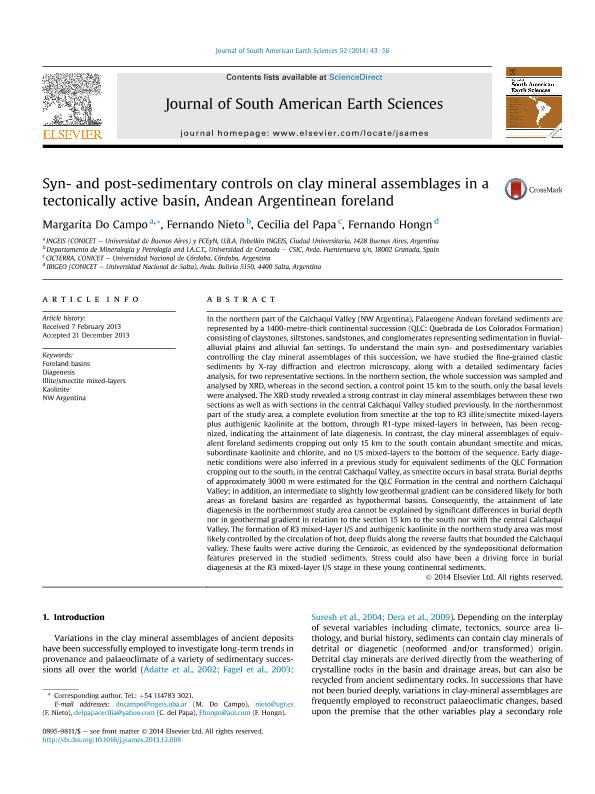Artículo
Syn- and post-sedimentary controls on clay mineral assemblages in a tectonically active basin, Andean Argentinean foreland
Fecha de publicación:
04/2014
Editorial:
Elsevier
Revista:
Journal of South American Earth Sciences
ISSN:
0895-9811
Idioma:
Inglés
Tipo de recurso:
Artículo publicado
Clasificación temática:
Resumen
In the northern part of the Calchaquí Valley (NW Argentina), Palaeogene Andean foreland sediments are represented by a 1,400-metre-thick continental succession (QLC: Quebrada de Los Colorados Formation) consisting of claystones, siltstones, sandstones, and conglomerates representing sedimentation in fluvial-alluvial plains and alluvial fan settings. To understand the main syn- and post-sedimentary variables controlling the clay mineral assemblages of this succession, we have studied the fine-grained clastic sediments by X-ray diffraction and electron microscopy, along with a detailed sedimentary facies analysis, for two representative sections. In the northern section, the whole succession was sampled and analysed by XRD, whereas in the second section, a control point 15 km to the south, only the basal levels were analysed. The XRD study revealed a strong contrast in clay mineral assemblages between these two sections as well as with sections in the central Calchaquí Valley studied previously. In the northernmost part of the study area, a complete evolution from smectite at the top to R3 illite/smectite mixed-layers plus authigenic kaolinite at the bottom, through R1-type mixed-layers in between, has been recognized, indicating the attainment of late diagenesis. In contrast, the clay mineral assemblages of equivalent foreland sediments cropping out only 15 kilometres to the south contain abundant smectite and micas, subordinate kaolinite and chlorite, and no I/S mixed-layers to the bottom of the sequence. Early diagenetic conditions were also inferred in a previous study for equivalent sediments of the QLC Formation cropping out to the south, in the central Calchaquí Valley, as smectite occurs in basal strata. Burial depths of approximately 3,000 metres were estimated for the QLC Formation in the central and northern Calchaquí Valley; in addition, an intermediate to slightly low geothermal gradient can be considered likely for both areas as foreland basins are regarded as hypothermal basins. Consequently, the attainment of late diagenesis in the northernmost study area cannot be explained by significant differences in burial depth nor in geothermal gradient in relation to the section 15 km to the south nor with the central Calchaquí Valley. The formation of R3 mixed-layer I/S and authigenic kaolinite in the northern study area was most likely controlled by the circulation of hot, deep fluids along the reverse faults that bounded the Calchaquí valley. These faults were active during the Cenozoic, as evidenced by the syndepositional deformation features preserved in the studied sediments. Stress could also have been a driving force in burial diagenesis at the R3 mixed-layer I/S stage in these young continental sediments.
Palabras clave:
Interestratificados Illita/Esmectita
,
Cuencas de Antepaís
,
Caolinita
Archivos asociados
Licencia
Identificadores
Colecciones
Articulos(CICTERRA)
Articulos de CENTRO DE INVEST.EN CS.DE LA TIERRA
Articulos de CENTRO DE INVEST.EN CS.DE LA TIERRA
Articulos(IBIGEO)
Articulos de INST.DE BIO Y GEOCIENCIAS DEL NOA
Articulos de INST.DE BIO Y GEOCIENCIAS DEL NOA
Articulos(INGEIS)
Articulos de INST.DE GEOCRONOLOGIA Y GEOLOGIA ISOTOPICA (I)
Articulos de INST.DE GEOCRONOLOGIA Y GEOLOGIA ISOTOPICA (I)
Citación
Do Campo, Margarita Diana; Nieto, Fernando; del Papa, Cecilia Eugenia; Hongn, Fernando Daniel; Syn- and post-sedimentary controls on clay mineral assemblages in a tectonically active basin, Andean Argentinean foreland; Elsevier; Journal of South American Earth Sciences; 52; 4-2014; 43-56
Compartir
Altmétricas




